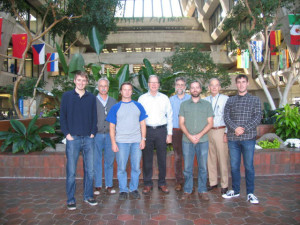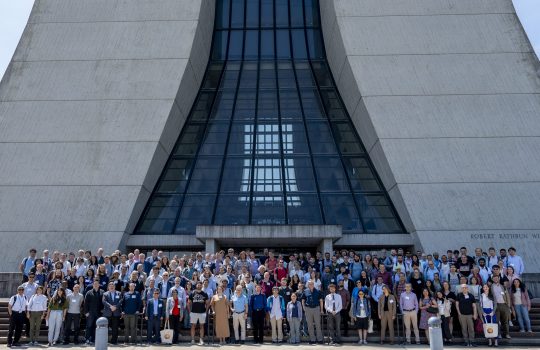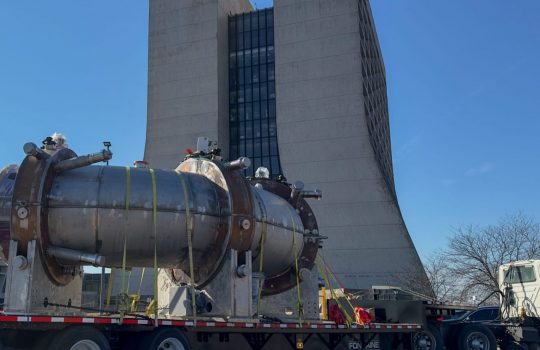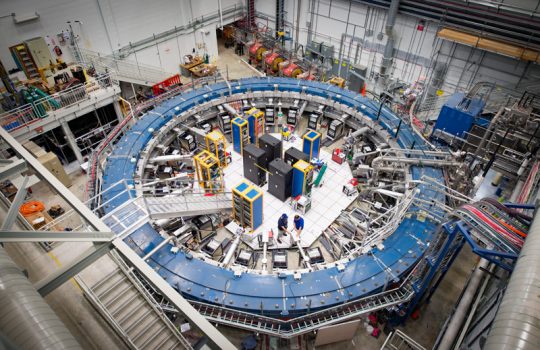
From left: Andrew Edmonds, Jose Repond, Vladimir Tishchenko, James Miller, Robert Bernstein, Anthony Palladino, Ed Hungerford and John Quirk are all members of both Mu2e and AlCap.
The search for physics beyond the Standard Model involves kidnapping. Seeking a never-before-seen phenomenon — the direct conversion of a muon into an electron — the forthcoming Mu2e experiment at Fermilab will kidnap muons and trap them in aluminum atoms. But what exactly happens when you shoot a muon at an aluminum foil?
While Mu2e is under construction, its scientists are already getting some valuable answers from a smaller accomplice: AlCap.
AlCap’s name is a smashup of “aluminum capture,” the kidnapping process the experiment studies. Hosted at the Paul Scherrer Institute in Switzerland, AlCap is currently measuring muon interactions in aluminum. It is a joint collaboration of members from both Mu2e and COMET, a muon experiment in Japan.
“It’s fostered cooperation, and there’s been some exchange of information,” said Jim Miller, Mu2e co-spokesperson, AlCap collaborator and professor at Boston University.
With a relatively small crew, all AlCap members have their hands in almost every part of the experiment, creating an excellent learning environment for younger members of the team.
“We started AlCap with a really green crew. In our first run, which was in December of 2013, we had to set up the entire experiment and do it in a period of about six weeks,” Miller said. We had an eager but inexperienced group of graduate students. They’d never been in a situation like that before, but they really learned a lot in a hurry, and now they’re experienced people.”
One of those students, John Quirk, is writing his thesis with AlCap data. Quirk, a research assistant at Boston University, has been involved in every step of AlCap, from preparation to data analysis. So are postdoctoral research scientists Anthony Palladino, at Boston University, and Andy Edmonds, at Lawrence Berkeley National Laboratory. All three of these early-career scientists also work on Mu2e with Miller.
In both AlCap and Mu2e, researchers shoot muons — a heavier cousin of the electron — at thin sheets of aluminum. Since a negatively charged muon is attracted to a positively charged aluminum nucleus, it will begin to orbit the aluminum nucleus as if it were an electron. AlCap shoots and stops a single muon at a time; Mu2e will stop about 10 billion muons every second.
Once it’s inside an aluminum atom, a muon can do one of three things. It might decay into an electron and two neutrinos, a common, pretty well-understood, process.
Or an aluminum atom’s nucleus could capture the muon — nuclear capture. In nuclear capture, a muon changes one proton in the aluminum’s nucleus into a neutron and produces a neutrino. AlCap is primarily investigating this process because it’s a potential source of background for Mu2e.
Scientists predict that a muon could do a third thing, something that’s never been seen before: convert directly into an electron without making any neutrinos. Mu2e seeks this rare event.
The electron produced directly from a muon captured by aluminum would have a telltale signature of 105 million electronvolts of energy. Some theorists predict this phenomenon happens frequently enough to be seen with a very sensitive detector. If the Mu2e detectors catch such signal electrons, it will be the discovery of physics beyond the Standard Model.
“The problem is that along with this signal electron, which may or may not be there, will come tons of protons and neutrons as other muons interact with aluminum nuclei during nuclear capture. These protons, for example, make very strong hits in the tracker that can blind us to looking for the signal,” Quirk said.
“Other backgrounds won’t blind the detector but could have such similar energies that they may mimic the 105-MeV signal,” Palladino said.
To ensure they’ll be able to pick out a 105-MeV electron from background, Mu2e researchers will use AlCap data to familiarize themselves with the pesky protons and other signal-fogging byproducts of nuclear capture, a process that is not well understood.
“We’re trying to update the numbers and get a better measurement with AlCap, because this process hasn’t been measured on aluminum for 40 years,” Edmonds said.
AlCap’s last data-taking run is this November. Scientists hope the data will also help determine the best way to count the number of muons stopped in Mu2e. When aluminum stops a muon, the interaction emits photons of different frequencies. AlCap hopes to figure out which frequency of photons Mu2e researchers should count as a proxy for the number of stopped muons.
Although the Mu2e crew is eager to find evidence of physics beyond the Standard Model, not finding any signal electrons may be just as exciting.
“That would slash away huge chunks of some of these beyond-the-Standard-Model models. Some models it will probably eliminate completely,” Miller said. “That will still be very interesting.”



